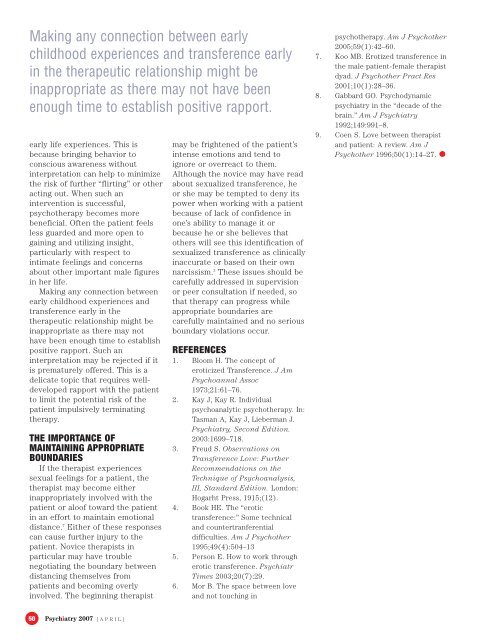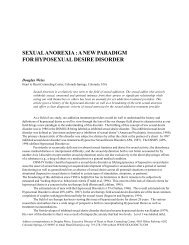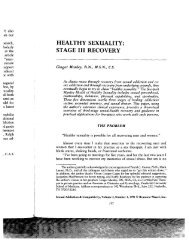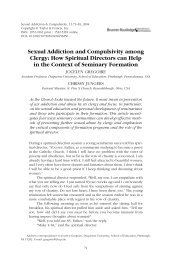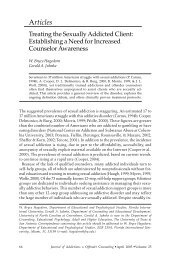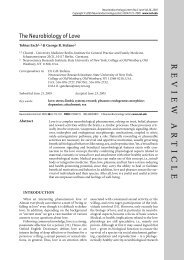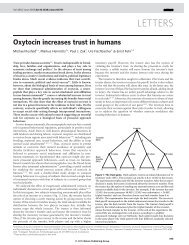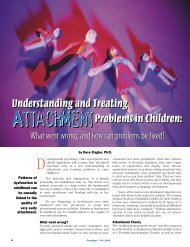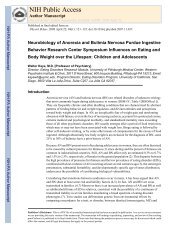recognizing and managing erotic and eroticized transferences
recognizing and managing erotic and eroticized transferences
recognizing and managing erotic and eroticized transferences
Create successful ePaper yourself
Turn your PDF publications into a flip-book with our unique Google optimized e-Paper software.
Making any connection between early<br />
childhood experiences <strong>and</strong> transference early<br />
in the therapeutic relationship might be<br />
inappropriate as there may not have been<br />
enough time to establish positive rapport.<br />
early life experiences. This is<br />
because bringing behavior to<br />
conscious awareness without<br />
interpretation can help to minimize<br />
the risk of further “flirting” or other<br />
acting out. When such an<br />
intervention is successful,<br />
psychotherapy becomes more<br />
beneficial. Often the patient feels<br />
less guarded <strong>and</strong> more open to<br />
gaining <strong>and</strong> utilizing insight,<br />
particularly with respect to<br />
intimate feelings <strong>and</strong> concerns<br />
about other important male figures<br />
in her life.<br />
Making any connection between<br />
early childhood experiences <strong>and</strong><br />
transference early in the<br />
therapeutic relationship might be<br />
inappropriate as there may not<br />
have been enough time to establish<br />
positive rapport. Such an<br />
interpretation may be rejected if it<br />
is prematurely offered. This is a<br />
delicate topic that requires welldeveloped<br />
rapport with the patient<br />
to limit the potential risk of the<br />
patient impulsively terminating<br />
therapy.<br />
THE IMPORTANCE OF<br />
MAINTAINING APPROPRIATE<br />
BOUNDARIES<br />
If the therapist experiences<br />
sexual feelings for a patient, the<br />
therapist may become either<br />
inappropriately involved with the<br />
patient or aloof toward the patient<br />
in an effort to maintain emotional<br />
distance. 7 Either of these responses<br />
can cause further injury to the<br />
patient. Novice therapists in<br />
particular may have trouble<br />
negotiating the boundary between<br />
distancing themselves from<br />
patients <strong>and</strong> becoming overly<br />
involved. The beginning therapist<br />
may be frightened of the patient’s<br />
intense emotions <strong>and</strong> tend to<br />
ignore or overreact to them.<br />
Although the novice may have read<br />
about sexualized transference, he<br />
or she may be tempted to deny its<br />
power when working with a patient<br />
because of lack of confidence in<br />
one’s ability to manage it or<br />
because he or she believes that<br />
others will see this identification of<br />
sexualized transference as clinically<br />
inaccurate or based on their own<br />
narcissism. 3 These issues should be<br />
carefully addressed in supervision<br />
or peer consultation if needed, so<br />
that therapy can progress while<br />
appropriate boundaries are<br />
carefully maintained <strong>and</strong> no serious<br />
boundary violations occur.<br />
REFERENCES<br />
1. Bloom H. The concept of<br />
<strong>erotic</strong>ized Transference. J Am<br />
Psychoannal Assoc<br />
1973;21:61–76.<br />
2. Kay J, Kay R. Individual<br />
psychoanalytic psychotherapy. In:<br />
Tasman A, Kay J, Lieberman J.<br />
Psychiatry, Second Edition.<br />
2003:1699–718.<br />
3. Freud S. Observations on<br />
Transference Love: Further<br />
Recommendations on the<br />
Technique of Psychoanalysis,<br />
III, St<strong>and</strong>ard Edition. London:<br />
Hogarht Press, 1915;(12).<br />
4. Book HE. The “<strong>erotic</strong><br />
transference:” Some technical<br />
<strong>and</strong> countertranferential<br />
difficulties. Am J Psychother<br />
1995;49(4):504–13<br />
5. Person E. How to work through<br />
<strong>erotic</strong> transference. Psychiatr<br />
Times 2003;20(7):29.<br />
6. Mor B. The space between love<br />
<strong>and</strong> not touching in<br />
psychotherapy. Am J Psychother<br />
2005;59(1):42–60.<br />
7. Koo MB. Erotized transference in<br />
the male patient-female therapist<br />
dyad. J Psychother Pract Res<br />
2001;10(1):28–36.<br />
8. Gabbard GO. Psychodynamic<br />
psychiatry in the “decade of the<br />
brain.” Am J Psychiatry<br />
1992;149:991–8.<br />
9. Coen S. Love between therapist<br />
<strong>and</strong> patient: A review. Am J<br />
Psychother 1996;50(1):14–27.<br />
50<br />
Psychiatry 2007 [APRIL]


